Useful Information about Driving in Australia
Self-driving holidays are one of the most relaxing ways to enjoy Australia’s landscape. Travelling between towns and cities with a Rad Rentals car hire allows you to thoroughly explore Australia’s scenic rural areas, and gives you the flexibility to stop at small country cafes, wineries and other points of interest, or simply pause to admire the view.
Australia’s tourist routes are a high standard and the main roads are sealed. All roads, including those in rural locations, are signposted.
Remember to drive on the left!
Driving Licences
What is a foreign driver licence?
A foreign driver licence is a licence to drive a motor vehicle issued to you under the law of another country.
Note: A New Zealand driver licence is also a foreign driver licence.
Can I drive a rental car in Queensland under my valid foreign driver licence?
When driving on a road in Queensland under your valid foreign driver licence you must:
- only drive the class of motor vehicle authorised on that licence
- comply with the conditions (if any) of your licence
- show your licence to a police officer when asked to do so.
If your licence is in a language other than English you should carry a recognised English translation of the licence.
When must I not drive in Queensland with my foreign driver licence?
You must not drive in Queensland on your foreign driver licence if:
- you have been disqualified from holding or obtaining a driver licence by an order of an Australian court
- your authority to drive on the licence has been suspended or withdrawn.
When would my authority to drive in Queensland on my foreign driver licence
be suspended?
Your authority to drive in Queensland on your foreign driver licence will be suspended if you have:
- not paid any fines imposed on you by a court
- accumulated an excess number of demerit points on your traffic history
- been convicted of driving at more than 40 kilometres per hour over the speed limit.
When would my authority to drive in Queensland on my foreign driver licence
be withdrawn?
Your authority to drive in Queensland on your foreign driver licence will be withdrawn if you:
- become medically unfit to drive safely
- are an Australian citizen and you have been residing in Queensland for three months
- are not an Australian citizen, but before you took up residence in Queensland you were given a resident visa and you have now been residing in Queensland for three months
- are not an Australian citizen, but after you took up residence in Queensland you were given a resident visa and you have now been residing in Queensland for three months since getting the visa.
Note: A resident visa means a permanent visa or a special category visa under the Migration Act 1958 (Commonwealth). These visas allow a person to stay indefinitely in Australia. Other visas, for example a temporary, business or guardian visa, that allows a person to stay in Australia for a limited time, or until a certain event happens or while they have a special status, is not a resident visa.
I hold a foreign driver licence. How do I get a Queensland driver licence?
To apply for a Queensland driver licence for the same class as your foreign driver licence, you will need to:
- complete the Driver Licence Application/Renewal form (F3000)
- show your foreign driver licence and a recognised English translation (if required)
- show your supporting evidence of identity including Queensland residency documents
- declare that you are medically fit to drive the class of motor vehicle
- Note: If you have a medical condition that is likely to adversely affect your ability to drive or ride safely, you are required to show a medical certificate from your doctor stating that you are medically fit to drive or ride safely.
- pay the licence fee.
You may also be required to:
- pass an eyesight test
- pay the road rules test fee and pass the test
- pay the practical driving test fee and pass the test.
For more information visit the Getting a Queensland licence (for overseas licence holders) page.
I have difficulty understanding or speaking English. What arrangements may be made to help me get a Queensland driver licence?
The Department of Transport and Main Roads can organise an interpreter to assist you during your road rules test if you have a genuine difficulty in understanding or speaking English.
However, you may need to tell the licence issuing officer what a number of selected traffic signs mean without the interpreter's help.
How do I learn about the road rules?
To learn about the Queensland road rules and generally driving in Queensland:
- visit our Queensland Road Rules page.
What will happen if I drive in Queensland when I am not allowed to?
If you drive in Queensland when you are not allowed to, you will be charged with unlicensed driving and you may have to appear in court. For more information, see driving without a licence.
Road Rules and Safety
Driving in Australia is not difficult, we have some tips here to make it even easier so there are no surprises for you when you drive around in your Rad Rentals hire car. Visit the Queensland Government website for more details. https://www.tmr.qld.gov.au/Safety/Queensland-Road-Rules.aspx
- Driving is always on the left-hand side of the road.
- Remember the 'give way to the right' rule.
- The maximum speed on any open road is 100km/h. The maximum speed in urban areas is 50km/h. Adjust your speed as conditions demand.
- Don't underestimate driving times. Although distances may seem short, Australias country roads include hilly, narrow or winding terrain, which slow down your journey. If you're used to driving in the city, take care when driving on the open country roads, and watch out for single-lane bridges.
- You must always wear a safety belt, both in the front and back seats - it's the law.
- Do not drink and drive in Australia - drinking and driving laws are strictly enforced.
- Follow other vehicles at a safe distance. A useful guide is the 'three-second rule': Watch the vehicle in front of you pass something like a sign, a tree or a power pole. See if you can count 'one thousand and one, one thousand and two before you pass the same object. If you cannot, slow down.
Child Restraints
Children must be properly restrained to ensure their safety while travelling in motor vehicles. From 11 March 2010, it's the law for all children up to seven years of age to be correctly restrained according to their size and age. It is important that the correct child restraint is chosen and installed. Don't risk a child's life, or serious injury to the most precious cargo you'll ever carry. The penalty for incorrectly securing a child is $A300 and three demerit points.
The following table is a guide to selecting a suitable child restraint.
A guide to child restraints
It is now the law for all children under seven years old to be correctly restrained according to their size and age.
Age
Indicative weight
Child restraint
0–6 months
Less than 8 kg
Rearward facing baby capsule or infant restraint
6 months–1 year
8–12 kg
Rearward or forward facing infant restraint
6 months–4 years
8–18 kg
Forward facing child restraint with built-in harness
4–7 years
14–26 kg
Booster seat with lap-sash H-harness or a booster seat with a secured adult seatbelt
Fuel in Australia
The majority of Australia cars run on unleaded petrol, while most four-wheel drive vehicles and campervans use diesel. It's dispensed by the litre and available in regular unleaded and premium unleaded. You can get fuel from service stations where you can also find small shops with basic grocery and magazines available.
Roundabouts
How do I identify different turns at a roundabout?
It is important to be in the correct lane at multi-lane roundabouts. Signs, lane markings and arrows help you position your vehicle correctly and guide you in the direction you want to go.
Unless traffic lane arrows indicate otherwise, remember these rules:
- to turn left, use the left lane.
- to turn right, use the right lane.
- to go straight ahead, use either lane.
Turning left
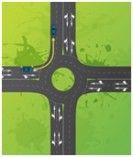
- Position your vehicle in the left lane unless arrows on the road or signs indicate otherwise.
- Use your left indicator when you enter the roundabout.
- Give way to all vehicles already on the roundabout.
- Remain in the left lane as you complete your turn.
- Continue to use your left indicator as you exit the roundabout.
- Stop indicating once you have exited the roundabout.
Turning right or U-turns
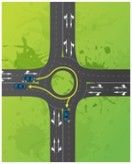
- Position your vehicle in the right lane unless arrows on the road or signs indicate otherwise.
- Use your right indicator when you enter the roundabout.
- Give way to all vehicles already on the roundabout.
- Before exiting, use your left indicator and follow the exit lane marking.
- Stop indicating as soon as you have left the roundabout.
Note: Do not turn right from the left lane unless arrows on the road indicate otherwise.
Going straight ahead
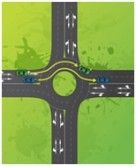
- Position your vehicle in either lane unless the arrows on the road or signs indicate otherwise.
- Do not use your indicator until ready to exit.
- Give way to all vehicles already on the roundabout.
- Before exiting, use your left indicator and follow the exit lane marking.
- Stop indicating once you have exited the roundabout.
Who gives way at a roundabout?
A vehicle approaching a roundabout must give way to all vehicles already on the roundabout.
In some cases on a multi-lane roundabout, it may be necessary to change lanes before exiting. In this situation, it is the responsibility of the driver changing lanes to give way to vehicles in the lane the driver is moving to.
Part 9 and Section 148 of the Queensland Road Rules apply.
Another way of looking at roundabouts
Turns that occur at roundabouts can be described by imagining the roundabout to be a clock face.
Any turn that exits the roundabout before 12 o'clock can be considered a left turn. Any turn that exits after 12 o'clock can be considered a right turn.
The Queensland Road Rules uses the terms 'less than half-way round' and 'more that half-way around'.
Straight ahead at a roundabout is taken to be at half-way around or at 12 o'clock.
TRANSIT LANE signs

These signs show where a transit lane begins and ends. A T3 TRANSIT LANE sign prohibits vehicles other than motorbikes, bicycles, public transport and vehicles with three or more occupants, from using the lane.
A T2 TRANSIT LANE sign means vehicles with two or more occupants are allowed to use the lane.
TRAFFIC SIGNS AND THEIR FUNCTION
Traffic signs are an essential part of the road traffic system. They give important information which helps all road users to move safely and with confidence.
There are at least 5 kinds of traffic signs in general use. The shape of a particular sign will help you recognise the purpose of the sign.
1. REGULATORY SIGNS
The first kind of sign is called a regulatory sign, and road users must obey the instructions shown on the sign.
A regulatory sign comes in four different shapes as follows—
• an octagon (or a plate with eight sides of the same length) which is only ever used for the STOP sign.
Example—

- an equilateral triangle (or a plate with three sides of the same length and one point downward) which is only ever used for the GIVE WAY and the ROUNDABOUT sign.
Examples—
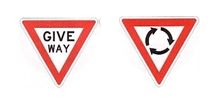
• a rectangle with its longer sides in the vertical (or upright) position which is used for those regulatory signs that do not have their own distinctive shape.
Examples—
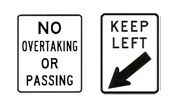
• a circle which is used for regulatory signs for pedestrian safety, hand banners and a closed railway crossing gate as follows—
Examples—
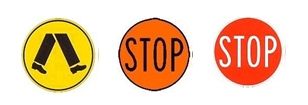
2. WARNING SIGNS
The second kind of sign is called a warning sign and gives important information about a permanent traffic hazard on the road ahead.
A warning sign comes in two different shapes as follows—
• A diamond (a plate with 4 sides of the same length with one point downward).
Examples—
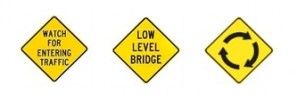
This warning sign may also have another sign (called an auxiliary sign) below it that gives additional information about the hazard, such as the distance in kilometres that the hazard may be present, or the recommended speed for comfortable travel through the hazard in good weather, traffic and road conditions.
Examples—
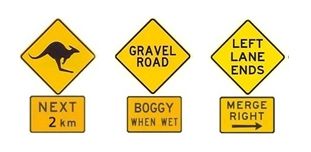
• A diagonal cross which is only used at railway level crossings.
Examples—

3. GUIDE SIGNS
The third kind of sign is called a guide sign and gives road users information about distances, destinations, routes, the location of services for them, points of interest and other traffic information.
A guide sign generally comes in the shape of a rectangle with its shorter sides in the vertical (or upright) position.
Examples—

4. TEMPORARY SIGNS
The fourth kind of sign is called a temporary sign that warns, instructs or guides road users through, around or past temporary hazardous conditions that could endanger them. They also reduce the danger to workers and machinery in a work site on, or beside, the road or footpath. The sign may also indicate the route to be taken by road users when travelling through, around or past work sites.
A temporary guide sign comes in the shape of a rectangle with its shorter sides in the vertical (or upright) position.
Examples—

5. HAZARD MARKERS
The fifth kind of sign is called a hazard marker. This sign is used to show approaching traffic that the road ahead has a significant change in the direction of travel, as well as the presence and width of an obstruction.
A hazard marker comes in the shape of a rectangle or a square.
Examples—
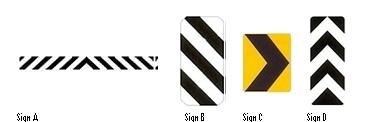
Motorists may drive to the right or to the left of sign A because the lower outside edges of the diagonal stripes are pointing in both those directions. Motorists must drive to the right of sign B because the lower outside edges of the diagonal stripes are pointing in that direction. The correct direction of travel past sign C is to the right because the vertical V-shaped stripe (chevron) on the sign is pointing in that direction. Motorists may drive to the right or left of sign D because the lower outside edges of the horizontal V-shaped stripes (chevrons) are pointing in both those directions.
Parking
Parking is available in inner city areas, in metered parks, parking buildings and shopping mall car parks. Councils administer parking, and wardens issue fines to vehicles that have parked illegally or that have expired meters.

Most cities have clearway zones and during certain times vehicles parked in these areas may be towed away. If this occurs, call the local traffic authority or police to find out where your car has been impounded. Retrieving the car involves paying an on-the-spot fine.
